Meet: Matt Lamanna
the New Dinosaur Expert at Carnegie Museum of Natural
History
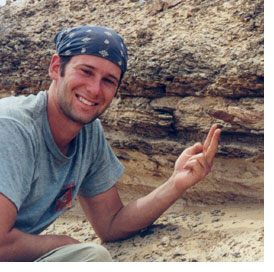 Carnegie Museum of Natural History recently welcomed
to its team Matthew Lamanna, a newly minted Ph.D.
from the University of Pennsylvania who is already
known
in paleontology circles as part of the team that
discovered a giant dinosaur species in Egypt. Lamanna
is assistant
curator of vertebrate paleontology and will oversee
the museum’s famous dinosaur collection. In
addition to his field work, his departmental priority
will be
to assist with the planning and creation of Dinosaurs
in Their World, the signature dinosaur exhibit now
being developed by Carnegie Museum of Natural History
as part of its first major expansion since Dinosaur
Hall was built more than 100 years ago. Carnegie Museum of Natural History recently welcomed
to its team Matthew Lamanna, a newly minted Ph.D.
from the University of Pennsylvania who is already
known
in paleontology circles as part of the team that
discovered a giant dinosaur species in Egypt. Lamanna
is assistant
curator of vertebrate paleontology and will oversee
the museum’s famous dinosaur collection. In
addition to his field work, his departmental priority
will be
to assist with the planning and creation of Dinosaurs
in Their World, the signature dinosaur exhibit now
being developed by Carnegie Museum of Natural History
as part of its first major expansion since Dinosaur
Hall was built more than 100 years ago.
As a young
paleontologist, Lamanna has been on a fast track
in a profession where desirable positions within
research museums are hard to find. But his educational
and professional choices worked well. Raised in
upstate New York, he went to Hobart College and double
majored
in biology and geoscience, then on to graduate
school at the University of Pennsylvania, where he
studied
dinosaur paleontology in the Department of Earth
and Environmental Science. There he came under
the influence
of well-known vertebrate paleontologist Peter Dodson,
who saw him as a young scientist of great potential.
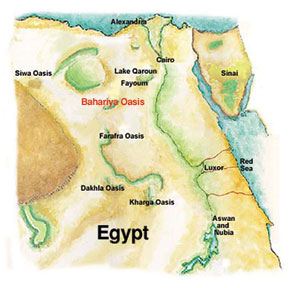 In 2000, Lamanna was on the team led by fellow Penn
graduate student Joshua Smith that searched
western
Egypt for a lost dinosaur site first discovered
by a German paleontologist in 1911. There, at
Bahariya Oasis, they discovered a sauropod (a long-necked,
plant-eating
dinosaur) as long as 80 feet and weighing 40-50
tons. Called Paralititan (“tidal giant”)
because it died in an ancient coastal environment,
it was one
of the largest animals ever to walk the earth.
The expedition was funded by the A&E network
and resulted in a two-hour documentary, The
Lost Dinosaurs of Egypt,
and a book published by Random House. It also gave
Lamanna immediate professional visibility, and
it was one of the best examples of a new approach
to finding
financial backing for scientific field work—entertainment
networks such as A&E have begun to sponsor
research that could later produce popular material
about science. In 2000, Lamanna was on the team led by fellow Penn
graduate student Joshua Smith that searched
western
Egypt for a lost dinosaur site first discovered
by a German paleontologist in 1911. There, at
Bahariya Oasis, they discovered a sauropod (a long-necked,
plant-eating
dinosaur) as long as 80 feet and weighing 40-50
tons. Called Paralititan (“tidal giant”)
because it died in an ancient coastal environment,
it was one
of the largest animals ever to walk the earth.
The expedition was funded by the A&E network
and resulted in a two-hour documentary, The
Lost Dinosaurs of Egypt,
and a book published by Random House. It also gave
Lamanna immediate professional visibility, and
it was one of the best examples of a new approach
to finding
financial backing for scientific field work—entertainment
networks such as A&E have begun to sponsor
research that could later produce popular material
about science.
“Most Egyptians don’t know that their
country is a rich source of dinosaur fossils,” Lamanna
says. “Antiquities have mostly overshadowed
paleontology in Egypt for a long time. A giant
carnivorous theropod
dinosaur, Spinosaurus, and other fossil animals
discovered by German paleontologist Ernst Stromer
in the early
20th century, were taken to Munich where they
were completely destroyed during Allied attacks
on the city
in World War II.” Lamanna hopes to help
bring paleontology to the forefront in Egypt,
and he plans
to return to the Bahariya Oasis again to continue
his research. In the summer of 2004, Lamanna’s
fieldwork took him to northern China in search
of dinosaurs and primitive
birds from the Early Cretaceous period (approximately
105 million to 125 million years ago). Also
on his agenda is research in Patagonia on new
species of sauropods,
theropods, and strange fossil relatives of
modern crocodiles.
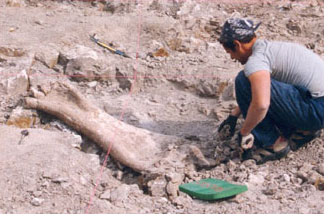 At Carnegie Museums, Lamanna
follows in the footsteps of noted dinosaur paleontologists
such as Jacob
Wortman, who discovered Diplodocus carnegii,
Earl Douglass,
who discovered the site in northeastern Utah
that became Dinosaur National Monument, and
John Bell
Hatcher,
who discovered Triceratops. For many decades
the museum has not had a scientist dedicated
to discovering
dinosaur
fossils—with the brief exception of
Hans Dieter-Sues, who left after one year
for an
appointment at the Smithsonian. At Carnegie Museums, Lamanna
follows in the footsteps of noted dinosaur paleontologists
such as Jacob
Wortman, who discovered Diplodocus carnegii,
Earl Douglass,
who discovered the site in northeastern Utah
that became Dinosaur National Monument, and
John Bell
Hatcher,
who discovered Triceratops. For many decades
the museum has not had a scientist dedicated
to discovering
dinosaur
fossils—with the brief exception of
Hans Dieter-Sues, who left after one year
for an
appointment at the Smithsonian.
Lamanna’s
decision to come to the Museum of Natural
History immediately gave him access to one
of the top three dinosaur collections in
the world, and one rich
in sauropod fossils. Lamanna thinks that
sauropods may have existed in greater variety
than we now know.
Although originally thought to be animals
of the swamps, more recently some sauropods
have been seen as land-dwellers.
He also feels that “the family-style
atmosphere of the section of vertebrate paleontology
is a big
plus, and helps to foster productivity. Each
scientist is working on a different project
and coming at it
in his or her own way. Even better, nobody
has an ego.”
Christopher Beard, head
of the museum’s section
of vertebrate paleontology, says the museum
is thrilled to add Lamanna to its team: “His
research promises to advance our understanding
of the diversity and evolution
of dinosaurs by leading expeditions to exotic
locations around the globe, in the same grand
tradition that
has long distinguished paleontology at Carnegie
Museums from its peers.”
Dine with the Dinosaurs Lecture Series
In 1854 in Great Britain, an artist and 20 scientists
had a famous dinner inside the hollow body of a
dinosaur. Now, 150 years later, Carnegie Museum
of Natural
History invites you to a sumptuous dinner with
its own paleontologists in Dinosaur Hall—a
special visit to that famous hall just before it
begins its
change into the new Dinosaurs in Their World exhibit.
The evening agenda includes cocktails at 6:30 p.m.,
dinner at 7 p.m., and a lecture at 8 p.m.
September 22: Dr. Chris Beard, Curator—a 2000
MacArthur Genius Fellow, Beard’s discovery of
the earliest primate in China has changed thinking
about the geographic origins of mammals.
October 13: Dr. Matthew Lamanna, Assistant
Curator—the
new dinosaur expert on the staff whose fieldwork includes
the discovery of Paralititan, one of the most massive
dinosaurs that ever lived.
Fee: Members: $100 per event, $375 for the total series
of four lectures that includes two more (November 10
and December 2). Non-members: $125 per event; $475
for the series. To register,
call 412.578.2479.
Ancient
Bronzes of the Asian Grasslands
from
the Arthur M. Sackler Foundation
October 2 , 2004 - January 2, 2005 
© Arthur
M. Sackler Foundation
Ancient Bronzes of the Asian Grasslands from the Arthur
M. Sackler Foundation presents the first major sampling
of art illustrating the personal decorations and equipment
of the horse-riding steppe dwellers of the late second
and first millennia. The bronze belt buckles, plaques,
and weapons of these ancient horsemen are technically
sophisticated, richly patterned, and ornate. Animal
motifs are a primary theme, including antlered stags,
wild boars, and birds of prey. The exhibition shows
how these steppe cultures used animal themes as symbols
to indicate tribe, social rank, and as connections
to the spirit world.
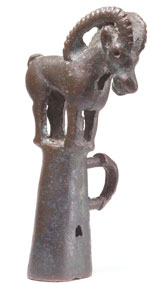 The exhibition brings to life the
complex cultures that flourished across the Asian
grasslands from northern
China and Mongolia into Eastern Europe. It shows
how these people influenced and were influenced by
the
culture of dynastic China, and it illustrates the
important role of the steppe dwellers in facilitating
trade and
travel along the Silk Route across Asia. The exhibition brings to life the
complex cultures that flourished across the Asian
grasslands from northern
China and Mongolia into Eastern Europe. It shows
how these people influenced and were influenced by
the
culture of dynastic China, and it illustrates the
important role of the steppe dwellers in facilitating
trade and
travel along the Silk Route across Asia.
Carnegie
Museum of Natural History is the first United States
museum to show this traveling exhibition,
which has been seen in Greece, Germany, Czechoslovakia,
Italy,
and Poland. The exhibition is organized by the
Arthur M. Sackler Foundation, New York. Arthur M. Sackler,
M.D. (1913–1987), a research psychiatrist,
medical publisher, connoisseur, and collector of
art, established
the Arthur M. Sackler Foundation in 1965 to make
his extensive art collections accessible to the
public.
Also on display will be an overview of
Carnegie Museum of Natural History anthropologist
Sandra
Olsen’s
research in northern Kazakhstan. Since 1993,
Olsen has been studying early horse domestication
and
recreating the lifestyles of the Botai culture
horse pastoralists,
who lived in the forest-steppe zone of northern
Kazakhstan over 5000 years ago, during a period
known as the Copper
Age.
This part of the exhibition will include
photographs, maps, and artifacts. It also will
allow visitors
to come face-to-face with a facial reconstruction
of a
Botai horseherder. Other highlights include
one of the earliest examples of multiple horse sacrifices
in a burial in Central Asia, pottery, jewelry,
and
other artifacts.
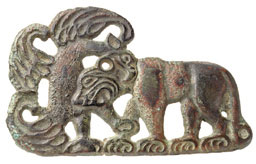 Programs: Programs:
Ancient Bronzes of the Asian Grasslands
October 2: Saturday Lecture Series
Ancient Steppe Bronzes: Who Wore Them and Why
Trudy S. Kawami, Director of Research Arthur M. Sackler
Foundation.
Carnegie Lecture Hall, 1 p.m.
The ancient peoples of the Asian steppes in the Iron
Age were herders and horse-raisers whose portable,
decorative art was based on the teeming animal life
around them. Learn about their art from the curator
of the exhibition.
October 16: Workshop
Felting
Cris Wagner, Section of Anthropology, Carnegie Museum
of Natural History
10:30 a.m.-3:30 p.m. in the Green Classroom; Members:
$25, Non-members: $30 (Includes lunch)
Felt is one of the most ancient of crafts on the Eurasian
grasslands and it continues to play a very important
role in the daily life of the people there today. Learn
more about this traditional craft with a visit to the
exhibit, and make a decorative felt project in the
Kazakh style.
October 19: Food for Thought Lecture Series
Ancient Bronzes of the Asian Grasslands
10:30 a.m.-4 p.m. in the CMA Theater
Members: $30; Non-members: $35 (Includes lunch)
Join Carnegie Museum of Natural History Curator Dr.
Sandra Olsen in a discussion of Ancient Bronzes
of the Asian Grasslands. Dr. Olsen has conducted research
in the Eurasian grasslands, primarily Kazakhstan, for
over 12 years. Following lunch in the museum café you
will participate in a felting workshop and a docent-guided
tour of the exhibit.
Activities continue in November and December. See
future announcements and calendars for specific topics,
times, and places.
Jendoco named Construction Manager for Dinosaurs in
Their World Project
Carnegie Museum of Natural History has selected Jendoco
Construction Corporation of Pittsburgh as Construction
Manager for its Dinosaurs in Their World expansion
project. Bill DeWalt, Director of Carnegie Museum of
Natural History Director, noted that, “Their
selection is another positive step forward and continues
the great momentum this project has. We are also pleased
that a local company of the quality of Jendoco will
be involved because of the positive economic benefits
it will have for the region.”
Since 1957, the
Jendoco team has built, renovated, and restored hundreds
of buildings in Pittsburgh and
western Pennsylvania, including such historic structures
as the Rodef Shalom Temple, Calvary Episcopal Church,
and the Pittsburgh Center for the Arts. They have
also transformed existing structures for new uses,
such
as the John Heinz Pittsburgh Regional History Center
for the Historical Society of Western Pennsylvania.
In
February, E. Verner Johnson and Associates of Boston
and the Pittsburgh office of Burt Hill Kosar
Rittelmann
Associates were selected as the project’s
architects.
Back to Contents |